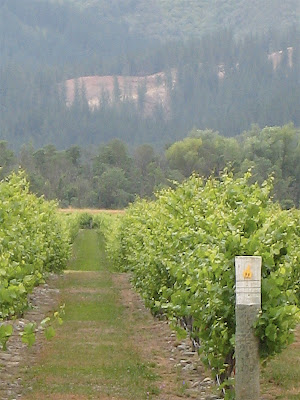There is nothing like a cold glass of
Sauvignon Blanc on a hot afternoon in the dog days of summer. As I watch the condensation roll down the outside of my glass, it takes me back to our trip last January to the wine country in New Zealand. I thought I would depart from our usual topic of local food from farm to plate, to talk about my favorite wine to have with these great meals.

Now, the basic and only rule of wine is that if it tastes good, it is good. Which wine goes with what dish can be a great source of fun experimentation. However, if you are not into experimenting the staff at Swoon
Kitchenbar takes great pride in helping you find a wine that will complement the food you want to eat. Some pairings can astonish you, which is why Swoon holds regular wine tasting dinners. Wine tasting dinners give you the chance to learn and experience food and wine together in a relaxed atmosphere, and they give Swoon a chance to extend its culinary artistry in ways you might not otherwise see.
Last January, Kathy and I went to Australia and New Zealand on a three week vacation. We have been wanting to go to the down under wine country since an experience we had at a wine tasting event held before the annual
Tanglewood Wine and Food Festival (this year on Saturday, August 11). A distributor of wines from New Zealand partnered with Old
Chatham Shepherding for a joint wine and cheese tasting, pairing different wines and cheeses. We had our first taste of New Zealand
Sauvignon Blanc and we were hooked after many years of drinking Italian
Pinot Grigio. What we saw and tasted after we arrived in Australia and later in New Zealand was far beyond our wildest dreams.

We toured the Hunter Valley just outside Sydney with our mate Haley who taught us the words and music to the theme for the TV show "Skippy the Bush Kangaroo" and tried to get us to have some
Vegemite. (By the way, they are as repulsed by peanut butter and jelly as we are by
Vegemite) Haley also clued us into the local slang created by just saying enough of a word to get the meaning. So
Sauvignon Blanc became a
Savi and the cooler for the beers is an
Eski (from the brand name Eskimo Cooler). We spent more time in New Zealand than in Australia, so we have more work to do on Australian wines.
After a brief stop in Auckland, NZ, we spent several days in Marlborough, NZ, which is at the North end of the Southern Island. We took advantage of another tour, and we enjoyed the local knowledge provided by the guide. We also enjoyed being able to let someone else drive among the wineries and then get us back to our hotel!
Marlborough is renowned for its white wines, most notably in the U.S. its
Sauvignon Blancs, which have a characteristically
citrusy flavor. The wineries we visited were the smaller
artisanal wineries that do not bottle enough wine to be viable as exporters. Most of them wanted us to try their
Pinot Gris and other wines so that we would have a broader view of them as wine producers. The tastes of the people in Australia and New Zealand for sweets is dramatically less than the tastes of the people in the U. S. and their wines showed the difference. The desert wines in New Zealand were quite different from desert wines from other regions. Marlborough is also starting to grow
Sangiovese grapes and might soon challenge Italy as they now do France with their
Pinot Noir.
If Marlborough is for white wine then the
Otego Valley outside
Queenstown, NZ, is for reds. The
Pinot Noirs and other reds we tasted the the
Otego Valley were outstanding. This area is on the Southern part of the Southern Island and is the mecca for skiers in June, and other extreme sports all year round. Keep in mind that in this part of the world, the further South you are the colder it gets.

Again, we toured the smaller wineries that take great care and pride in producing their wines, but don't produce enough to make shipping to the U.S. a viable option. So wines from Chard Farm or
Gibbston Valley that we loved while we were there might only be found rarely in the U.S. There is one other issue that comes up often with wines from New Zealand and Australia, and that is the screw cap closure. Some people have an emotional attachment to cork. A distributor for New Zealand wineries told me that he regularly lost 20% of the wine he imported from New Zealand due to
TCA cork rot. Screw caps have come a long way from the 1960s gallon jug of Gallo wine. They seal the bottle better preventing oxidation and taint, and reseal better after opening without the need for a vacuum stopper.
On several occasions while traveling on business I have been chosen to pick the wine for the group at dinner. I almost always pick a New Zealand
Sauvignon Blanc and
Pinot Noir, and get rave reviews. In fact last night we opened the last bottle of NZ
Pinot Noir we had left over from our wedding a year ago. Come on, unscrew a cap and give it a try.
David Jackson

 Sweet corn risotto w/ olive oil poached shrimp & cherry tomato sauce.
Sweet corn risotto w/ olive oil poached shrimp & cherry tomato sauce.

